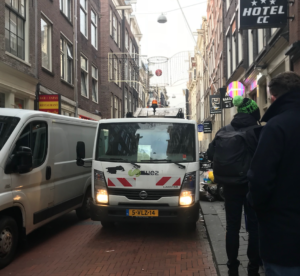Up to now, the impact of city logistics on enhancing air quality within urban areas has been restricted. While the emphasis on adopting clean vehicles is beneficial for air quality, it is essential to address the creation of economically viable, essential, and health-promoting city centers and neighborhoods in formulating urban freight policies. The central focus should be on achieving “zero impact” city logistics.
Cities experience poor air quality characterized by various substances, particulate matter, and gases. One of the threats to our health stems from the particles emitted during combustion in diesel engines. Consequently, our air quality is regulated by European standards to address these concerns.
Amsterdam’s coughing corridors
The levels of particulate matter and nitrogen dioxide consistently surpass established standards. My street in Amsterdam has earned the designation of a “coughing corridor” by Friends of the Earth. However, the situation is equally dire in Rotterdam and numerous European cities such as Paris and London. Even in areas meeting European standards, the air quality falls short of being truly healthy—an aspect acknowledged by supporters and critics alike.
The role of city logistics in improving air quality
In the Amsterdam metropolitan region, 35% of nitrogen dioxide emissions and 10% of the particulate matter come from road traffic. The transport of goods is responsible for 20 to 25% of that. It’s safe to say that city logistics has already significantly contributed to cleaner air in the cities. The heavier Euro 5 and Euro 6 trucks that are still allowed to enter the low-emission zones of cities are reasonably clean. Now, it’s cleaner carrier freezing and refrigeration that needs attention.
With their significant 80% contribution to city logistics, the imperative is clear – it’s about time we enhance the cleanliness of delivery vans. Implementing more stringent low-emission zones would undoubtedly expedite making nearly a million delivery vans in the Netherlands more environmentally friendly. Notably, some Dutch cities have committed to achieving zero-emission city logistics by 2025, a goal that the transport industry actively supports.
Five years from now, the concern about air quality in city logistics may become obsolete. Perhaps it’s time to reconsider the persistent mantra associated with air quality in city logistics. What were the initial goals and methods of those city logistics measures? Shouldn’t the primary focus be fostering economically viable, vibrant, and healthy city centers and neighborhoods? Isn’t addressing the urgency of accelerating climate change far more pressing?

CO2 and noise
In the upcoming years, the emphasis on city logistics should shift towards addressing another crucial aspect of “zero-emission” – CO2. To align with the Paris Climate goals, the transport sector must enhance its carbon productivity sixfold. Significant improvements can still be achieved, given considerable room for progress, even with just one-third of the current CO2 emissions in transport, particularly in city logistics.
Smarter and less: zero impact
Indeed, city logistics extends beyond merely achieving clean and zero-emission transportation. The emphasis should shift towards implementing smarter practices, particularly minimizing transport: reducing and flexibly utilizing public spaces for loading and unloading, enhancing traffic safety, employing smaller vehicles, optimizing traffic flow, minimizing noise, preventing damage to buildings and infrastructure, rewarding effective city logistics with privileges, and intelligently provisioning (new) residential areas—all while aiming for zero-emission and zero-impact city logistics.
